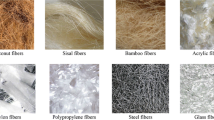Abstract
The casting of fiber-reinforced concrete presents greater handling difficulty and requires more deliberate planning and workmanship than conventional concrete without fibers. The feasibility of producing fiber-reinforced, self-consolidating concrete (FR-SCC) that can be cast into place with minimum or no consolidation was investigated. Sixteen mixtures made with steel fibers measuring 38 mm in length used at dosages of 0, 0.5, and 1%, by volume, were investigated. The mixtures were prepared with various types of binary and ternary cementitious materials and W/CM of 0.37 to 0.45. The higher W/CM mixtures incorporated a viscosity-enhancing agent to reduce the risk of segregation. Concrete mixtures with slump flow consistencies of 650 and 530 mm were prepared, with the latter representing a highly flowable concrete that would require some consolidation. The characteristics of these mixtures were compared to those of a conventional fiber-reinforced concrete with a targeted slump consistency of 200 mm. The mixtures were tested for rheological parameters using a concrete viscometer, for restricted deformability using the filling capacity and V-funnel flow tests, as well as for compressive strength and flexural toughness. The paper evaluates the suitability of using the above workability tests to assess restricted deformability of FR-SCC and discusses the effect of fiber volume, mixture proportioning, and consistency on concrete properties.
Résumé
L'utilisation de fibres métalliques dans le béton améliore plusieurs de ses caractéristiques. Cependant, les bétons avec fibres sont plus difficiles à mettre en place et requièrent donc une planification et une main-d'oeuvre plus importante. La possibilité de produire des bétons autoplaçants renforcés de fibres métalliques qui peuvent être mis en place avec peu ou pas de consolidation a été évaluée. Seize mélanges de béton, faits avec des fibres d'acier de 38 mm de longueur à des dosages de 0, 0,5 et 1,0% en volume, ont été confectionnés. Les mélanges ont été préparés avec différents types de liant binaire et ternaire et un rapport E/L de 0,37 à 0,45. Les bétons ayant un plus haut rapport E/C contenaient un agent de viscosité pour assurer la stabilité du mélange. Des bétons autoplaçants avec un étalement de 650 et 530 mm ont été fabriqués. Les mélanges de béton de 530 mm d'étalement, tout en étant très fluides, requièrent une énergie de consolidation limitée. Les caractéristiques de ces mélanges ont été comparées à un béton conventionnel avec fibres de 200 mm d'affaissement. La mesure des paramètres rhéologiques à l'aide d'un rhéomètre à béton a été faite, ainsi que la mesure de la déformabilité restreinte à l'aide de la capacité de remplissage et du test de l'entonnoir. De plus, la résistance à la compression ainsi que la ténacité à la flexion ont été déterminées. Cet article évalue la pertinence de l'utilisation de ces essais pour obtenir la déformabilité restreinte des bétons autoplaçants avec fibres et discute de l'effet du volume de fibre, des proportions du mélange et de la consistance sur les propriétés du mélange.
Similar content being viewed by others
References
Balaguru, P. and Shah, S., ‘Fiber-Reinforced Cement Composites’, (Mc-Graw-Hill, Inc., 1991).
‘ACI Manual of Concrete Pratice Part 5’ (American Concrete Institute, 1993).
Yang, C.-A., Chern, J.-C. and Miao, B., ‘Effects of steel fiber content on properties of high-performance concrete’, in ‘High-Performance Concrete’, Supplementary Papers of ACI International Conference, Malaysia, (1997) 355–369.
Roy, C., ‘High-performance, fiber-reinforced self-consolidating concrete’, Technical Report, Université de Sherbrooke (1996).
Ozawa, K., Sakata, N. and Okamura, H., ‘Evaluation of self-compactibility of fresh concrete using the funnel test’, Proceedings, Japan Society of Civil Engineering (1995) 59–75.
Yurugi, M., Sakata, N., Iwai, M. and Sakai, G., ‘Mix proportion for highly workable concrete’, in ‘Concrete 2000’, Proceedings, Dundee (1993) 579–589.
Beaupré, D., ‘Rheology of high performance concrete’, Ph.D. Thesis, University of British Columbia, Canada (1994).
Annual Book of ASTM Standards’, volume 04.02 Concrete and Aggregates (American Society for testing and Materials, 1996).
Takenaka, H., Kakizaki, M., Abe, Y. and Okada, M., ‘Effects of specimen preparation on the properties of fresh and hardened high fluidity concretes’, Proceedings, Fourth CANMET/ACI/JCI International Symposium-Advances in concrete technology, Japan (1998) 605–616.
Khayat, K., Ghezal, A. and Hadriche, M., ‘Factorial design models for proportioning self-consolidating concrete’,Mater. Struct. 32 (1999) 679–686.
Toit, S., Steyn, A. and Stunpf, R. ‘Graphical Exploratory Data Analysis’, (Springer Texts in Statistics, 1986).
Author information
Authors and Affiliations
Additional information
Editorial Note This paper was presented during the First International RILEM Symposium on Self-Compacting Concrete, Stockholm (Sweden) 1999, edited by Å. Skarendahl and Ö. Petersson (RILEM Proceedings PRO7, ISBN: 2-912143-09-8).
Rights and permissions
About this article
Cite this article
Khayat, K.H., Roussel, Y. Testing and performance of fiber-reinforced, self-consolidating concrete. Mat. Struct. 33, 391–397 (2000). https://doi.org/10.1007/BF02479648
Received:
Accepted:
Issue Date:
DOI: https://doi.org/10.1007/BF02479648




